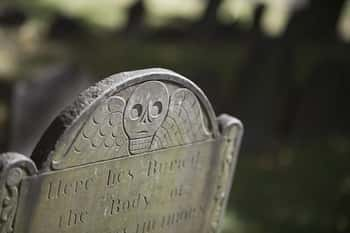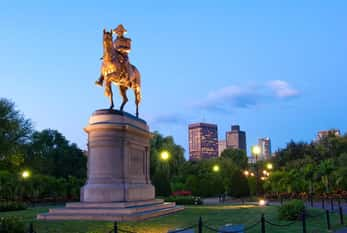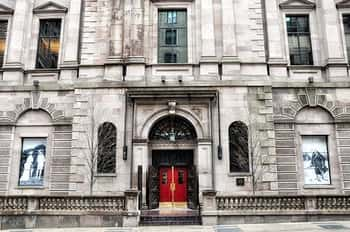When cosmic horror author H. P. Lovecraft uses a cemetery as the setting for one of his stories, you know the place is special. Copp's Hill, located in the North End of Boston, Massachusetts, comes alive at the stroke of midnight, chilling those who venture through its gates down to the bone. As the home to artists, religious leaders, pirates, and pioneers, it is no wonder that this graveyard is famous for its exciting entities and spooky legends.
Located on a hill previously occupied by the colony's first windmill, Copp's Hill Burying Ground, has stood since 1659 as the second-oldest cemetery in the city. Before its establishment, the North End area experienced a surge in its population, with the increasing number of new residents making the allocation of a local burial ground an urgent necessity.
A large portion of land, belonging to two separate owners, was purchased by the city and designated as the North Burying Ground. The name was subsequently changed to Copp's Hill after William Copp, an esteemed shoemaker who lived nearby.
Following a string of deadly epidemics (such as smallpox and yellow fever), the colony had no choice but to acquire additional space to accommodate the deceased, which led to the graveyard's multiple expansions.
The first occurred in 1708 when the city purchased land from none other than Salem witch trial judge, Samuel Sewall, and the second happened a century later, in 1809. In 1819, a cemetery established by Boston mayor Charles Wells was merged with Copp's Hill, leaving the boundaries between the two burial grounds virtually indistinguishable.
With land taken from Copp's Hill for early 19th-century construction projects around the city, the once peaking summit was flattened. This - of course - affected the soil's drainage and caused erosion, which, in turn, made the headstones sink into the ground, giving the already frightening cemetery the appearance of being swallowed by the depths of the earth.
During the occupation of Boston - particularly before the 1775 Battle of Bunker Hill - the grounds became essential to the British military. It was here where, amongst the graves, British forces tested their cannons and muskets, taking advantage of the hill's height and panoramic view of the harbor.
With complete disregard for the dead, the British shot the grave markers to practice their aim before the battle. Out of all the bullet-ridden headstones in the cemetery, Captain Daniel Malcolm's stands out the most. The Sons of Liberty member was known for being a blatant duty-evading wine smuggler. Blacklisted by British authorities, he requested to be buried 10-feet-deep to avoid having his remains dug up by vengeful enemies. This, however, didn't stop the British army from spitefully assaulting his epitaph.
Copp's Hill is home to the remains of the African-American community - "New Guinea" - established at the foot of the hill. The typical wooden markers placed for non-white burials, naturally deteriorated quickly, explaining why the westernmost side of the cemetery carries dozens - possibly hundreds - of unmarked graves.
By the start of the Revolution, more than 1,000 free and enslaved African-Americans were buried in this location. However, many of the remains were moved when the city began the construction of Snow Hill Street. The graves were exhumed and re-interred in other areas of the cemetery, often omitting the placement of grave markers. Some believe this carelessness sparked visitors' odd encounters with disturbing shadow figures and the glowing lights often witnessed by residents of the buildings on Snow Hill.
When touring the grounds, stop by the Mather Family Tomb, which houses infamous Puritans and Salem witch trial witnesses, Increase and Cotton Mather. A minimal, sleek headstone marks the grave of Robert Newman, the man who hung the church signal lanterns on the night of Paul Revere's midnight ride.
Aside from harboring religious leaders and patriots, Copp's Hill is home to notable poet, Phillis Wheatley, the first African-American to be published, and Black Freemasonry founder, Prince Hall. Edmund Hartt, builder of the USS Constitution, the oldest fully commissioned warship in the Navy, is also a Copp's Hill resident.
The largest monument in the cemetery, the Children's Tomb, is a granite mausoleum used to store the remains of infants who passed before they could be baptized and therefore believed to be damned for eternity.
But local legends had other ideas about the mausoleum. According to Nicholas Dello Russo, in his article Life on the Corner: A Copp's Hill Mystery, he would gather around the tomb with his friends when he was a teenager. Dello Russo explains how the group would always discuss the rumor that it was the entrance to a system of underground tunnels, used by pirates to transport treasure and to smuggle booze during Prohibition.
After breaking the lock and daring their most eccentric friend to venture through the thick, iron door, the small bones confirmed this was, indeed, an infants' tomb.
A paranormally charged, often unsettling part of town, Copp's Hill is the place to encounter Bostonian spirits from all walks of life. It is said that North Enders avoid walking along the cemetery sidewalk at all costs, likely due to the strange lights and noises they have witnessed throughout the years. Those who live in the adjacent apartment buildings have heard everything from muffled cries to painful groans coming from across the street.
There are two figures in the cemetery known for their loud, jarring voices, the Mathers. Increase has been said to torment visitors, with the same intensity he displayed throughout his life. Cotton, on the other hand, is believed to be visited frequently by the witches he helped identify and convict, explaining why many claim to have heard his late-night exhibits of sorrow.
The Copp’s Hill Burying Ground is managed by the Historic Burying Grounds Initiative within Boston’s Parks and Recreation Department.
The burial ground is open to the public from 9:00 a.m. to 4:00 p.m. free of charge.
45 Hull Street
Boston, MA 02113

Learn more about Boston's most haunted Cemetery

Boston Common is Boston's haunted hotspot

Boston's haunted Library, haunted by Literary Giants